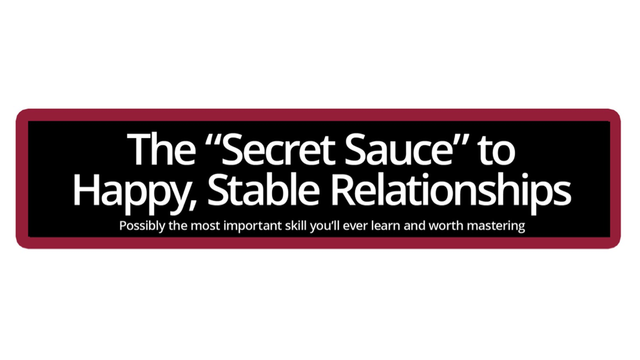“Secret Sauce” to Happy Relationships
April 11th, 2017

Much like location is a critical piece of investing in real estate, the exact can be said about honest and open communication when it comes to relationships.
What do we mean by open honest communication besides the obvious?
To truly communicate both parties must take part in active listening.
The first thing you must learn is that active listeners are experts at the art of not talking. However this doesn’t mean you not engaged in the conversation, it simply means you’ve stopped talking and shifted complete focus and attention to what the other person is saying.
Letting the other person know you are hearing them, truly listening and understanding what they’re saying is vital. According to Barker (2014) active listening is the first thing FBI hostage negotiators use to de-escalate incidents and save lives. This is active listening. It has three main components we all should work towards understanding: paraphrasing, inquiry and acknowledgement (Barker, 2014).
“The technology developed by Sandy Pentland and his colleagues at MIT Media Lab counts the number of times people say “uh-huh,” “yeah,” “yup,” “aha,” “okay,” and “I see” when they’re listening to someone speak. In Pentland’s study, the more short interjections a man made, the more attractive he was to the woman who was talking” (Barker, 2014).
Seriously, how can we argue with the fact some happy moments during our day can be made a bit better when we share them with our loved ones and they show support with their response?
The fundamentals of active listening are pretty straightforward:
- Listen to what they say. Don’t interrupt, disagree or “evaluate.”
- Nod your head, and make brief acknowledging comments like “yes” and “uh-huh.”
- Without being awkward, repeat back the gist of what they just said, from their frame of reference.
- Ask questions that show you’ve been paying attention and that move the discussion forward.
When you implement active listening your partner may begin to feel like you “get it” and understand them. Heck, you probably will be more in the know because you used active listening.
No one likes to think the person they’re talking to is judging them, formulating a response before they’re done speaking or that the person they’re confiding in is looking for holes in their story to prove why they’re wrong.
Once you begin showing your partner you are trying to understand their viewpoint and when you communicate that to them with your verbal and nonverbal behavior…wow, watch how happy you two become.
Since our spouse or significant other isn’t someone we’re looking to have release hostages we must ask if this technique works in relationships.
Without a doubt we can say YES IT DOES! Some say active listening is hot, it’s sexy and it gets the sexual motors revving up, give it a try when you’re done reading this and let us know if it worked for you.
Please remember, it’s not a one-and-done type of technique…this is a practice, something that will take time to learn and implement. Hey, active listening has been tested in a lab setting even, so there is some statistical proof it works.
Is your partner, or anyone, actively listening to you?
Here are a few non-verbal clues they’re actively listening:
Smile
Small smiles can be used to show that the listener is paying attention to what is being said or as a way of agreeing or being happy about the messages being received. Combined with nods of the head, smiles can be powerful in affirming that messages are being listened to and understood.
Eye Contact
It is normal and usually encouraging for the listener to look at the person they are speaking with. Eye contact can however be intimidating, gauge how much eye contact is appropriate for any given situation. Combine eye contact with smiles and other non-verbal messages to encourage your partner and let them know you are paying attention.
Posture
Posture can tell a lot about the sender and receiver in interpersonal interactions. The active listener tends to lean slightly forward or sideways while sitting. Other signs of active listening may include a slight slant of the head or resting the head on one hand.
Mirroring
Automatic reflection/mirroring of any facial expressions used by your partner as you communicate can be a sign of active listening. These reflective expressions can help to show sympathy and empathy in more emotional situations. Attempting to consciously mimic facial expressions (i.e. not automatic reflection of expressions) can be a sign of inattention. Not good.
Distraction
The active listener will not be distracted and therefore will refrain from fidgeting, looking at a clock or watch, doodling, playing with their hair or picking their fingernails.
Now let’s look at what is considered verbal clues they’re actively listening:
Positive Reinforcement
Casual and frequent use of words and phrases, such as: ‘very good’, ‘yes’ or ‘indeed’ can be reassuring to the person speaking and allow him or her to know you are truly paying attention. It is usually better to elaborate and explain why you are agreeing with a certain point.
Although some positive words of encouragement may be beneficial to the person speaking the listener should use them sparingly so as not to distract from what is being said or place unnecessary emphasis on parts of the message.
Remembering
The human mind is notoriously bad at remembering details, especially for any considerable length of time.
However, remembering a few key points can help to reinforce that the messages sent have been received and understood – i.e. listening has been successful.
Remembering details, ideas and concepts from previous conversations proves that attention was kept and is likely to encourage the person you are with to continue.
Questioning
The listener can demonstrate that they have been paying attention by asking relevant questions and/or making statements that build or help to clarify what the person speaking has shared with you. By asking relevant questions the listener also helps to reinforce that they have an interest in what theit partner has been saying.
Reflection
Reflecting is closely repeating or paraphrasing what the speaker has said in order to show comprehension. Reflection is a powerful skill that can reinforce the message of the speaker and demonstrate understanding.
Clarification
Clarifying involves asking questions to your partner to ensure that you have received the correct message. Clarification usually involves the use of open questions that enables your partner to expand on certain points as necessary.
Summarization
Repeating a summary of what has been said back to your partner is a technique used by the listener to repeat what has been said in his or her own words.
Summarizing involves taking the main points of the received message and reiterating them in a logical and clear way, giving the speaker a chance to correct if necessary.
References:
Barker, E. (2014, November 1). How You Can Learn the #1 Persuasion Technique of FBI Hostage Negotiators: http://time.com/3549602/persuasion-technique-fbi-hostage-negotiators/
Active Listening | SkillsYouNeed. (2015): http://www.skillsyouneed.com/ips/active-listening.html








